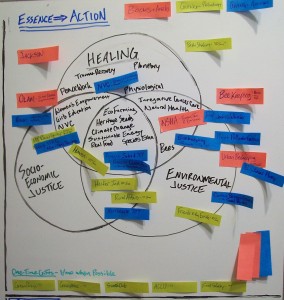Try this Invaluable Tool for Revising Your Book—or Your Life!
 Whatever your political leanings, if you’re a deep thinker (every writer is), these are disturbing times. Disruption at this intensity has most of us asking bedrock questions about purpose and values. We’re all wondering: What really matters in my work and life and, of course, my writing?
Whatever your political leanings, if you’re a deep thinker (every writer is), these are disturbing times. Disruption at this intensity has most of us asking bedrock questions about purpose and values. We’re all wondering: What really matters in my work and life and, of course, my writing?
In that spirit, I took time recently to mind-map my writing life. I began with that core question: what really matters to me? What activities am I involved in that contribute to my deepest sense of purpose? Which activities and tasks are merely clutter? Which ones seem “nice” on the surface, but are only eating my time?
Over the course of a few weeks, the chicken-scratch map in my notebook evolved into a three-circle map on my whiteboard. Now there’s a mix of marker notes about driving purpose and easily movable sticky-notes. I’ve written the names of individual projects and activities on the stickies. I can literally see which projects in my work and personal life actually resonate with my values—some resonate with multiple values; I need to make those my priorities.
I can also see which pursuits don’t resonate anywhere. Those are likely clutter and may need to be pruned.
The mind map’s overall form looks a bit familiar. Anyone who’s worked with me in a coaching relationship has learned about mapping when trying to determine what a book is trying to say on a deep thematic level.
Some clients do this at the beginning of a project. Some absolutely cannot do it until they’ve got at least half of their initial shitty rough draft written. Some use this tool at multiple points throughout writing and revision as a regular check-up. Themes can indeed evolve and shift from the start of a book-writing journey to its end.
Whether mapping your life or your book, the strategy is the same. With a book project, instead of personal values, you’re looking for your book’s 2 or 3 driving themes.
- A business inspiration book might be focused on whole person success, balancing dreams with logistics, and saying no so you can say yes to what matters.
- A memoir might wrestle with the resilience of codependent families and the irrational stubbornness of love.
- Your new plunge into mystery writing might be all about fear of death, the layered nature of deception, and the shadow side of genius.
When you feel you’ve begun to identify those core themes, write them as bold domains on a large sheet of paper or whiteboard. Then start to write 3-5 word tags for the scenes that have come to you. I prefer to use sticky notes for this, so I can physically move the tags around.
Can you see now how each scene overlaps with and serve one of your identified themes? Use that to heighten the applicable themes in each scene. Are there any squirrely scenes that seem important but you’re not sure where to place them? Are there scenes that still sit at the outskirts with no clear connection at all? The latter may be a clue that it’s time to say goodbye to that block of content. It’s clutter.
Like an activity that’s sapping your personal time and not in line with your core values, the out-of-alignment scene must be pruned. Clutter scenes often resist loudly. Sometimes it’s the very first scene you wrote when the book idea first came to you. There’s a sentimentality there. If sentimentality is the only reason to hang onto a scene, that’s yet another clue that it would be best to let it go.
Revision requires such ruthless decisions.
Whether you’re mind-mapping your life or your next book project, this is a fantastic tool for breaking out of “muddy thinking” and overwhelm. Not sure where to go next? It’s best to consult your map first!
